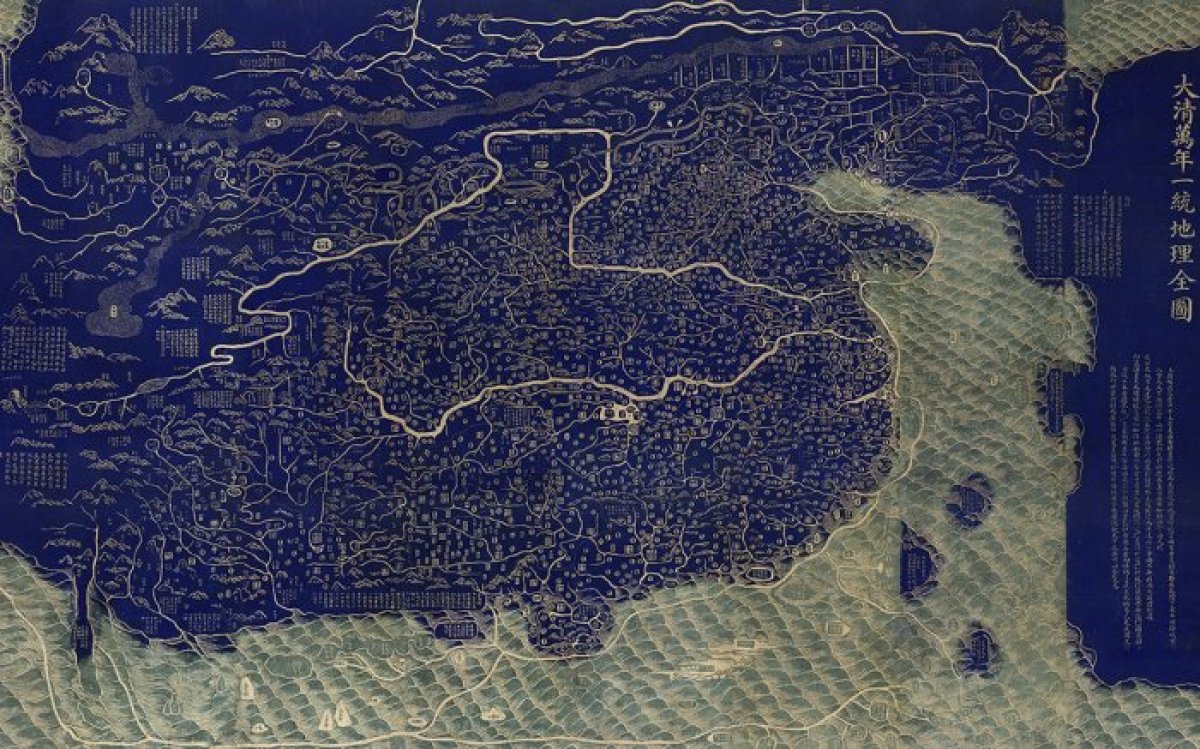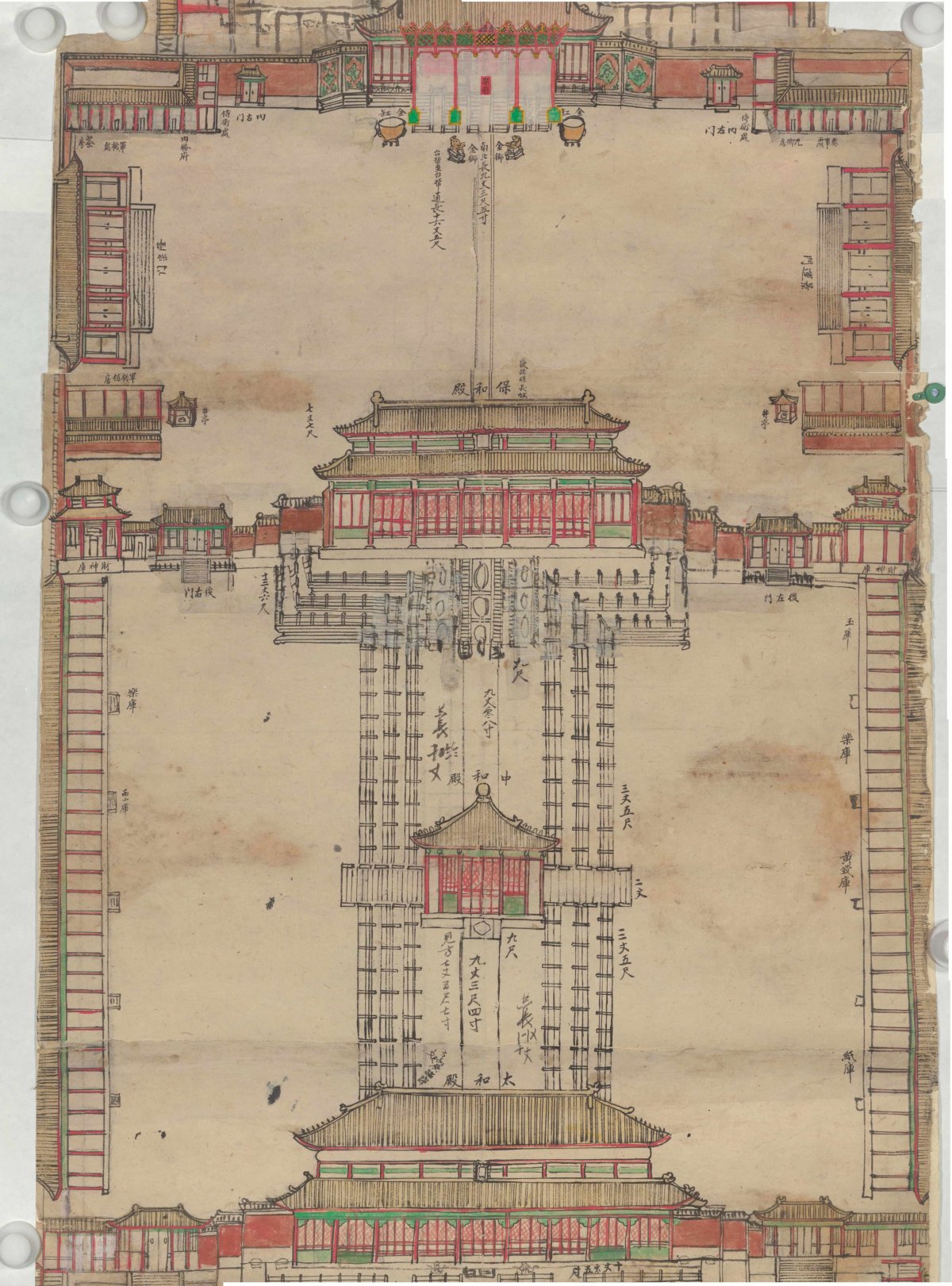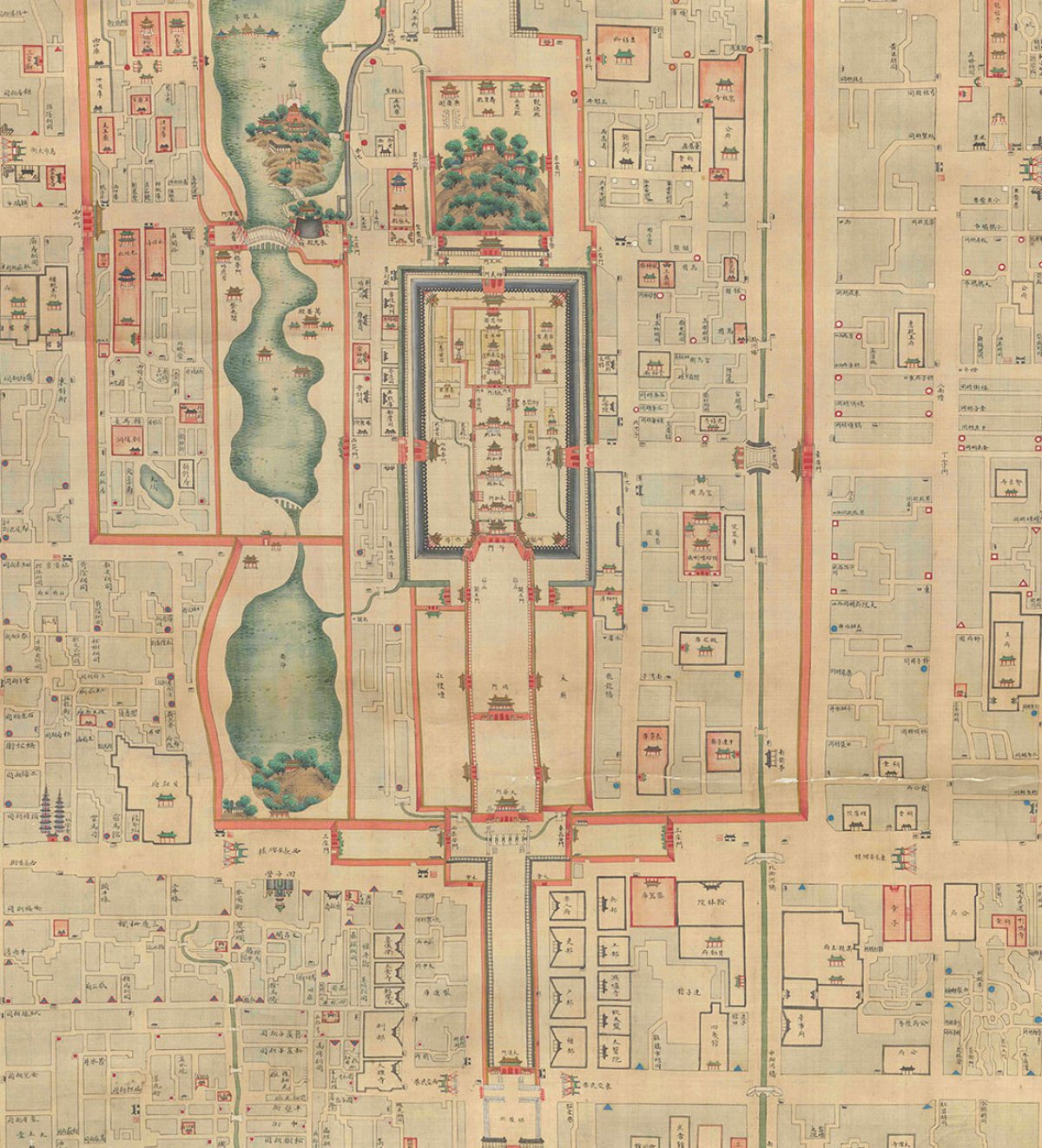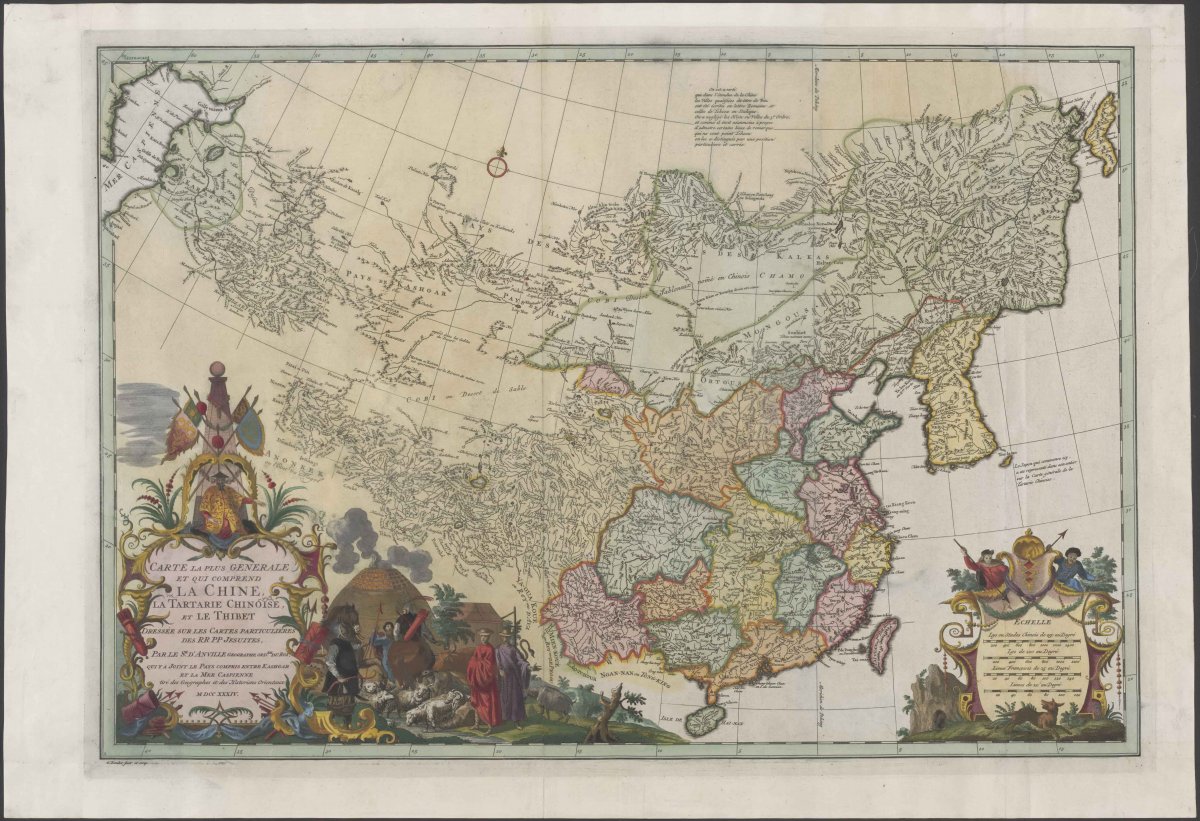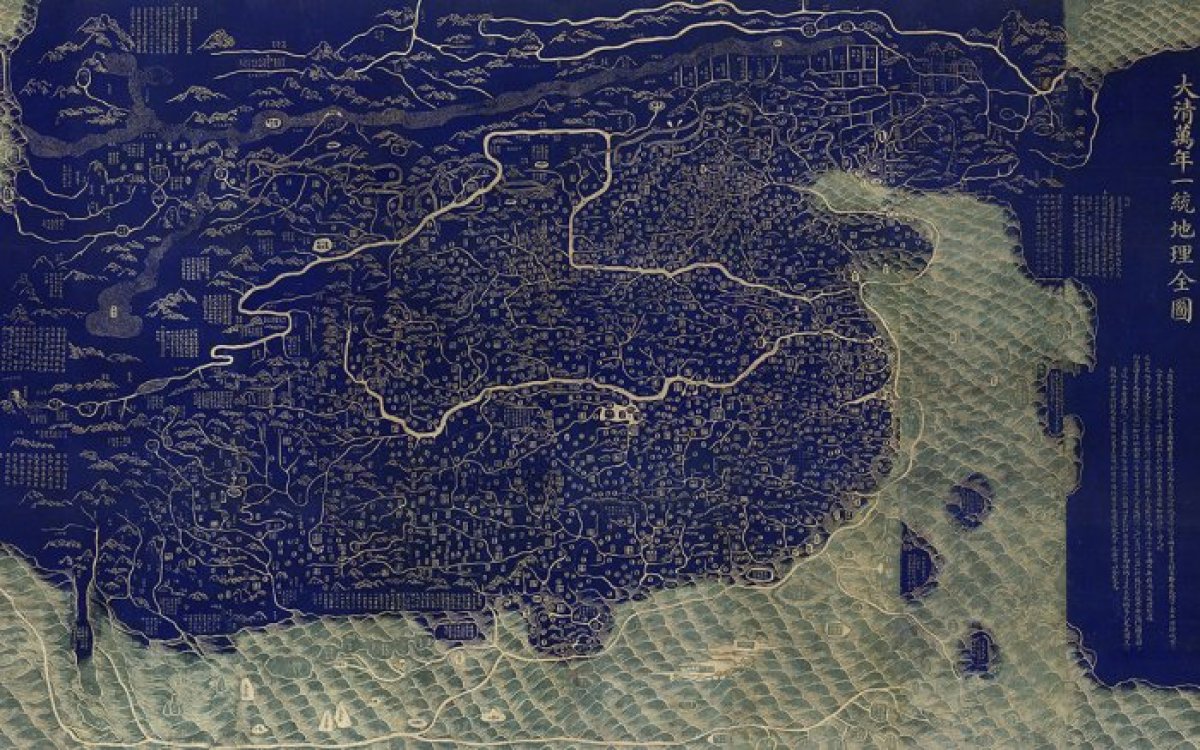
After Huang Qianren (1694–1771), Complete Map of the Everlasting Unity of the Great Qing (Da Qing wannian yitong dili quantu), Jiaqing period (1796–1820), National Library of China
The Qing dynasty, sometimes referred to as the Empire of the Great Qing, or the Manchu dynasty, was the last imperial dynasty of China. Over almost three centuries, the Qing dynasty formed the territorial base for the modern Chinese state. It drew together peoples of different cultures under a small administration, creating a unique entity that was for a time one of the richest and most powerful states in the world.
This map, the Complete Map of the everlasting Unity of the Great Qing, was designed to impress.
It was drawn as an administrative map identifying the provincial and local centres of government. The Manchu homelands to the northeast of Beijing and parts of Mongolia, interestingly, are shown divided by straight lines, reflecting the military and administrative arrangements under the so-called Banners and leagues.
The map is a cultural tool of the Qing court for asserting its success in ruling over such a vast territory. The complete map is a rubbing across eight scrolls.
The Qing dynasty, sometimes referred to as the Empire of the Great Qing, or the Manchu dynasty, was the last imperial dynasty of China. Over almost three centuries, the Qing dynasty formed the territorial base for the modern Chinese state. It drew together peoples of different cultures under a small administration, creating a unique entity that was for a time one of the richest and most powerful states in the world.
This map, the Complete Map of the everlasting Unity of the Great Qing, was designed to impress.
It was drawn as an administrative map identifying the provincial and local centres of government. The Manchu homelands to the northeast of Beijing and parts of Mongolia, interestingly, are shown divided by straight lines, reflecting the military and administrative arrangements under the so-called Banners and leagues.
The map is a cultural tool of the Qing court for asserting its success in ruling over such a vast territory. The complete map is a rubbing across eight scrolls.
The Manchu court succeeded in ruling China proper for nearly three centuries, as well as administering parts of Mongolia and the Islamic northwest. They remained conscious of the need to understand local and traditional structures in order to rule effectively over such a culturally diverse territory, and engaged with Tibet in different ways.
1. Have your students investigate the strategies used by the Manchu to manage the broader empire. They might focus their attention particularly on:
- language
- religion
- administrative structure
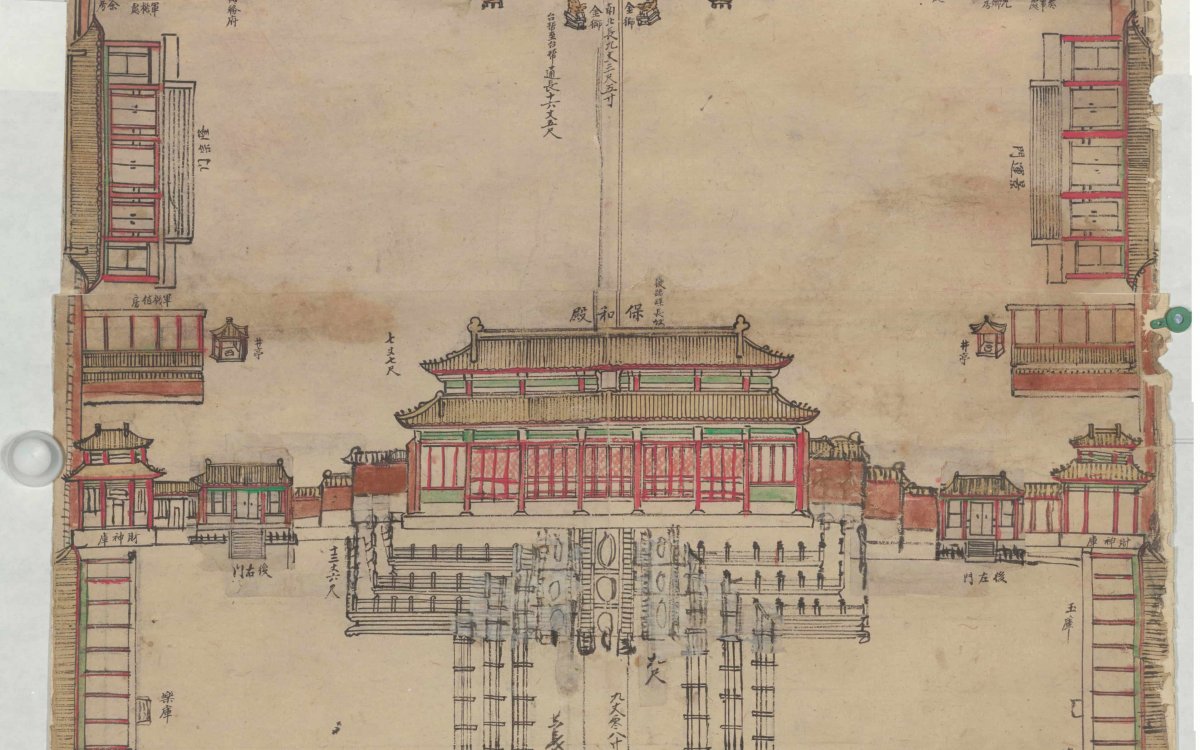
Plan of the Route from the Gate of the Great Qing to the Palace of Earthly Tranquillity, Guangxu period (1875–1908), Yangshi Lei Archives, National Library of China
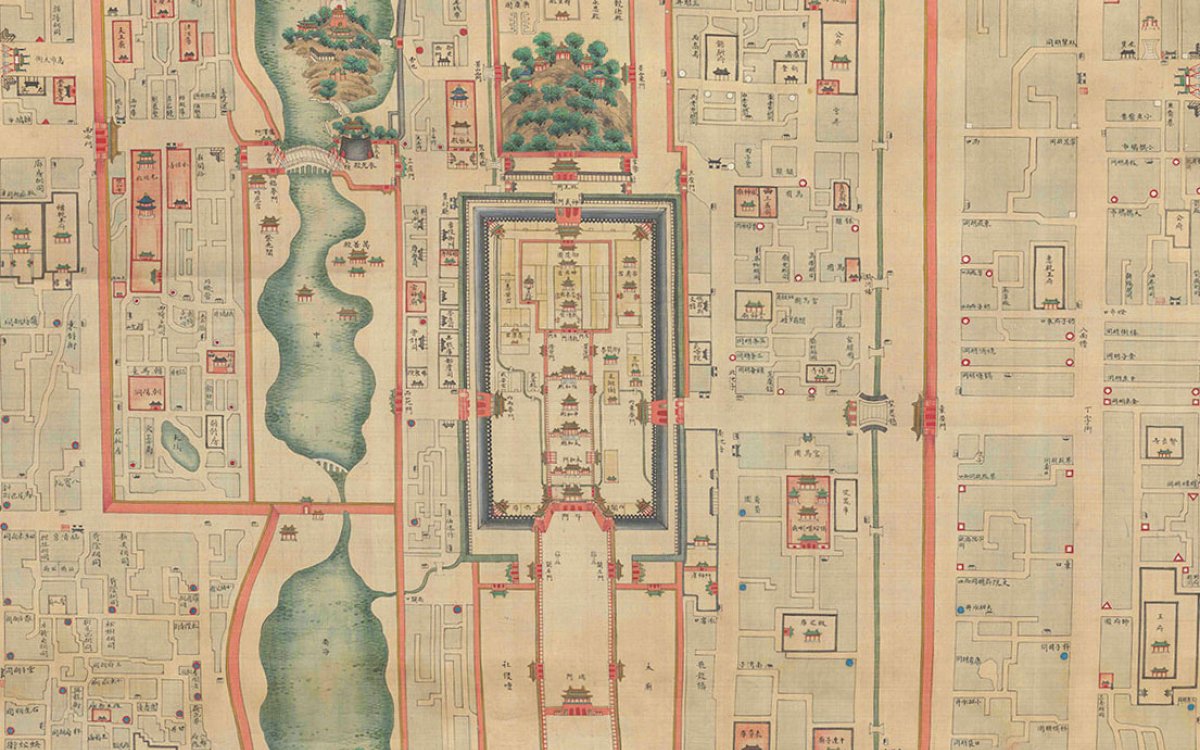
Map of Beijing (Beijing neiwaicheng quantu) (detail), Daoguang period (1821–1850), National Library of China
China’s capital has not always been Beijing. The capital has been located in many places over the last 2,000 years. In the early fifteenth century the Yongle Emperor (1403–1424) of the Ming moved the capital from Nanjing to Beijing, and the building of the original walled palace—which became the Forbidden City—took place during 1416–1420.
Early emperors, used to roaming over immense territories, found the walled palace not to their liking and spent long months each year at the garden palaces to the northwest of Beijing, at the extensive mountain lodge at Chengde (often called in the West ‘Xanadu’), and the adjacent Mulan hunting grounds or on tour around their territories.
The architectural design of the Forbidden City reflects the early Chinese principle that order is maintained by imposing divisions.
Entrance is through the towering 35 metre Meridian Gate, which during the Qing period dominated the skyline of Beijing (no building was allowed to be higher). The Gate was named after the prime longitude of the early Chinese compass, and towers over a north–south axis along which the Palace is symmetrically arranged.
The public space in the southern portion, where the public rituals were performed, is organised in an aesthetic form of cosmic perfection. The key buildings are named the Hall of Supreme Harmony, Hall of Preserving Harmony and Hall of Heavenly Purity.
These documents come from the archives of the Lei family, the long-serving imperial architects over centuries. The archives held by the National Library of China have been inscribed on the UNESCO Memory of the World register.
China’s capital has not always been Beijing. The capital has been located in many places over the last 2,000 years. In the early fifteenth century the Yongle Emperor (1403–1424) of the Ming moved the capital from Nanjing to Beijing, and the building of the original walled palace—which became the Forbidden City—took place during 1416–1420.
Early emperors, used to roaming over immense territories, found the walled palace not to their liking and spent long months each year at the garden palaces to the northwest of Beijing, at the extensive mountain lodge at Chengde (often called in the West ‘Xanadu’), and the adjacent Mulan hunting grounds or on tour around their territories.
The architectural design of the Forbidden City reflects the early Chinese principle that order is maintained by imposing divisions.
Entrance is through the towering 35 metre Meridian Gate, which during the Qing period dominated the skyline of Beijing (no building was allowed to be higher). The Gate was named after the prime longitude of the early Chinese compass, and towers over a north–south axis along which the Palace is symmetrically arranged.
The public space in the southern portion, where the public rituals were performed, is organised in an aesthetic form of cosmic perfection. The key buildings are named the Hall of Supreme Harmony, Hall of Preserving Harmony and Hall of Heavenly Purity.
These documents come from the archives of the Lei family, the long-serving imperial architects over centuries. The archives held by the National Library of China have been inscribed on the UNESCO Memory of the World register.
1. While the Lei family’s plans for the imperial palaces are inscribed on UNESCO Memory of the World register, the sites themselves are also recognised by the UN cultural agency on its World Heritage List.
There are ten selection criteria against which World Heritage sites are selected. The Imperial Palaces of the Qing Dynasty fulfil requirements against criteria i-iv:
(i) to represent a masterpiece of human creative genius;
(ii) to exhibit an important interchange of human values, over a span of time or within a cultural area of the world, on developments in architecture or technology, monumental arts, town-planning or landscape design;
(iii) to bear a unique or at least exceptional testimony to a cultural tradition or to a civilization which is living or which has disappeared;
(iv) to be an outstanding example of a type of building, architectural or technological ensemble or landscape which illustrates (a) significant stage(s) in human history
Have students prepare a significance assessment for including the Imperial Palaces of the Qing Dynasty on the World Heritage List following the actual criteria outlined above.
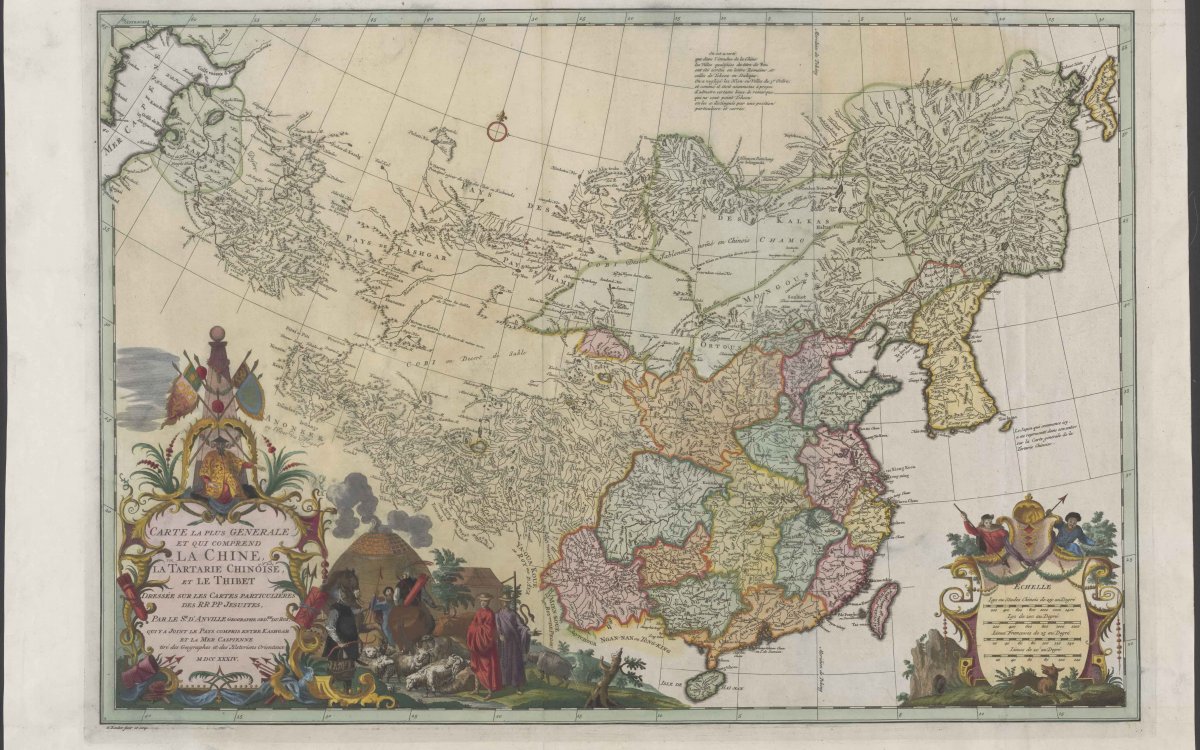
Scheurleer, Henri & Condet, Gerardus, 1731-1764 & Anville, Jean Baptiste Bourguignon d', 1697-1782. Nouvel atlas de la Chine, de la Tartarie chinoise et du Thibet. (1737). Carte la plus generale et qui comprend la Chine, la Tartarie chinoise, et le Thibet [cartographic material] / dressee sur les cartes particulieres des RR PP jesuites, par le Sr. d'Anville, geographe ordre. du roi, qui y a joint le pays compris entre Kashgar et la mer Caspienne tire des geographes et des historiens orientaux, 1734. http://nla.gov.au/nla.obj-232293356
This map of China was drawn by Jean Baptiste Bourguignon d’Anville (1697–1782), a French cartographer. It was published in The Hague in 1737 in Nouvel Atlas de la Chine. It is one of four general maps: one each of China, Tibet and Tartary (Manchuria and adjacent parts of inner Asia); and one displaying all of these together.
D’Anville’s China maps have been called ‘the standard Western source for the geography of China and adjacent regions throughout the nineteenth century’. One of d’Anville’s aims was to reform geography by putting an end to the blind copying of older maps and to only include proven information. He was happy to have blank areas on maps.
Information on the maps came from land surveys made by the Chinese empire between 1708 and 1718 under the reign of the Kangxi Emperor. D’Anville worked from a set of these maps sent to Europe and data from European sources.
This map of China was drawn by Jean Baptiste Bourguignon d’Anville (1697–1782), a French cartographer. It was published in The Hague in 1737 in Nouvel Atlas de la Chine. It is one of four general maps: one each of China, Tibet and Tartary (Manchuria and adjacent parts of inner Asia); and one displaying all of these together.
D’Anville’s China maps have been called ‘the standard Western source for the geography of China and adjacent regions throughout the nineteenth century’. One of d’Anville’s aims was to reform geography by putting an end to the blind copying of older maps and to only include proven information. He was happy to have blank areas on maps.
Information on the maps came from land surveys made by the Chinese empire between 1708 and 1718 under the reign of the Kangxi Emperor. D’Anville worked from a set of these maps sent to Europe and data from European sources.
D’Anville’s maps were based on land surveys conducted with the aid of French Jesuits, several of whom had been expressly sent to China by Louis XIV of France in 1685 in order to collect geographical information. Explore some or all of the following questions with the group using the Think-Pair-Share strategy.
- Who were the Jesuits?
- Investigate the biographies of Jesuit missionaries sent to China by Loius XIV:
- Louis Le Comte (1655–1728)
- Jean de Fontaney (1643–1710)
- Jean-François Gerbillon (1654–1707)
- Claude de Visdelou (1656–1737)
- Joachim Bouvet (1656–1730)
- What was the French’s interest in China at the end of the seventeenth century?
- How does this map fit into the Western world’s understanding of China during the eighteenth century?
